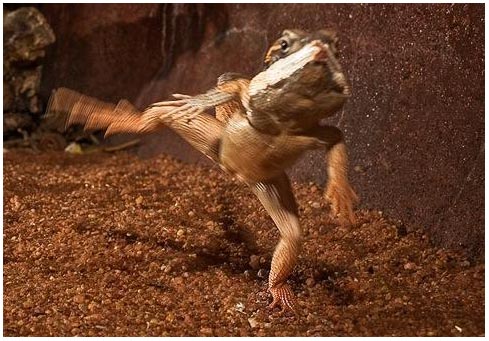Why do lizards run on two limbs?
Why must we run only by spending after all four genera that have been created are coordinated with each other very smoothly? This is the question that caused Christofer Clemente to have a headache.
For birds and primates, there is only one perfect answer: birds have transformed the forelimbs into wings, primates must use their hands to do more suitable things. So why do some lizards become bipedal? Did they evolve to trot with two feet or are their upright postures simply a lucky gift? Desperate to find an answer, Clemente and his colleagues Philip Withers, Graham Thompson and David Lloyd decided to learn how dragon lizards developed a two-legged way.
The first thing Clemente has to do is catch these lizards. Luckily Thompson is the master at catching lizards. Across Australia in remote areas, Clemente and Thompson finally managed to capture 16 species of flying lizards, from the ancient crested lizard to the extremely rare C. rubens lizard found on a farm. distant western Australia Returning to Perth lab, Clemente and Withers let the lizards run on the treadmill and film them until they were all exhausted.

Why must we run only by spending after all four genera that have been created are coordinated with each other very smoothly?(Photo: Simon Pynt, Courtesy Dr. C. Clemente)
Clemente confessed that when he first started, he thought that lizards could split into two groups: the group of lizards running mostly on foot or sometimes using all four legs; and the group of lizards never stood straight but ran on two legs. But the truth is not like that. Even lizards he had never seen running on two feet in nature tried to take a few steps with his hind legs. Actually, the lizard's tendency to run on both legs seems to be continuous. C. rubens and P. minor only spend about 5% of their time on hind legs while L. gilberti uses 95% of the time.
Curious to find out if the bipedal mechanism had evolved, Clemente erected the lizard's genealogy tree and plotted the proportion of the time each lizard species used the latter but he did not detect it. out of any relationship. Lizard does not evolve to go on two legs. Some cause caused them to release their forebears, but what was the cause?
According to Clemente, other research groups also suggested a number of reasons for lizards. Perhaps running on two feet would be faster and more economical than running on all fours. But when Clemente analyzed the video of the lizard scene running, he realized that running on hind legs actually cost more energy while two-legged athletes were no faster than its quadruple counterparts. . Knowing that, Peter Aerts argued that lizards improved their flexibility by shifting their body mass to their hips. Clemente wondered if the lizards' front limbs were freed from the ground because of the central location of the body mass displaced. Perhaps they are acting like we lift the front wheel off the ground.
Collaborating with David Lloyd and modeling lizard movements when they accelerated, scientists found a strong link between their acceleration and the front limb lifted off the ground. Clemente explains that by shifting the weight of the body weight - the act of moving force on the body, lifting the two front limbs off the ground helps them run when standing upright. Therefore running on two limbs is a natural result of fast running in lizards. Clemente added: 'Some flying lizards have exploited this result and opted to be biped because it has some advantages. But we still don't know what those advantages are. '
Reference article:
Clemente, CJ, Withers, PC, Thompson, G. and Lloyd, D. Why go bipedal? Locomotion and morphology in Australian agamid lizards (Why become Australia's agamid lizard). The Journal of Experimental Biology, vol 21, p. 2058-2065, June 13, 2008.
- Detecting lizards 'penguin limbs amputated'
- Discover new lizards in Kon Tum
- Detecting lizard-legged lizards
- Are people about to regrow their limbs like salamanders?
- Why are limbs cold in winter?
- The world was once dominated by a toothless giant
- Strange reproductive practices of lizards
- Observe the extremely rare 'reverse evolution' lizard species in the natural world for the first time
- The species of Florida lizards evolved rapidly due to invasive species pressure
- Discovered new lizards living isolated for millions of years
- How to help you avoid hateful numbness
- Discover more new flying lizards
 Animal 'suffering' after hibernation
Animal 'suffering' after hibernation Why do goats climb well?
Why do goats climb well? Scientists were surprised to see chimpanzees eating turtles
Scientists were surprised to see chimpanzees eating turtles Giant catfish died deadly due to drought in Thailand
Giant catfish died deadly due to drought in Thailand Giant carnivorous lizards rage in the United States
Giant carnivorous lizards rage in the United States  Lizards change their eating habits when the climate rises 2 degrees Celsius
Lizards change their eating habits when the climate rises 2 degrees Celsius  The tail lizard then grows back: The ability to make this person jealous turns out to be a huge trade-off
The tail lizard then grows back: The ability to make this person jealous turns out to be a huge trade-off  Discover more of the terrifying ability of carnivorous plants in North America
Discover more of the terrifying ability of carnivorous plants in North America  Jurassic monster revealed
Jurassic monster revealed  Discover new flying lizards in Patagonia
Discover new flying lizards in Patagonia 